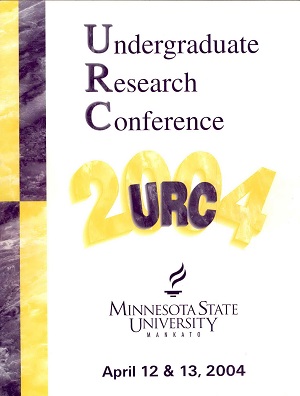Mineral-Promoted Degradation of Pharmaceuticals: Aspirin as a Model Compound
Location
CSU 253
Start Date
13-4-2004 10:30 AM
End Date
13-4-2004 12:00 PM
Student's Major
Chemistry and Geology
Student's College
Science, Engineering and Technology
Mentor's Name
Trenton Vorlicek
Mentor's Department
Chemistry and Geology
Mentor's College
Science, Engineering and Technology
Description
The persistence of pharmaceuticals in the environment and their effects on the environment and biological life is an emerging issue currently being debated in the scientific community. Al though an effort has been made to quantify the presence of pharmaceuticals in the environment, the area concerning the degradation pathways of pharmaceuticals has not been thoroughly investigated. One aspect that has not been researched is the effect minerals may have in the degradation of pharmaceuticals. Soils and sediments contain minerals which come in contact with aqueous systems that contain pharmaceutical residues. By ignoring the interactions of minerals and their role in the degradation of pharmaceuticals, the estimated persistence of pharmaceuticals in the environment may be over predicted. The interaction between the mineral compound, alumina (Al2O3), and the pharmaceutical, aspirin, will be studied as a model to predict catalysis of similar pharmaceuticals by minerals abundant in soils and sediments. This project focuses on exploring the kinetic relationship between the hydrolysis of aspirin and the concentration of alumina. A positive correlation between the concentration of alumina and an increase in the rate of aspirin hydrolysis supports the hypothesis that minerals catalyze the degradation of pharmaceuticals in the environment; therefore, mineral catalyzed degradation warrants further studies.
Mineral-Promoted Degradation of Pharmaceuticals: Aspirin as a Model Compound
CSU 253
The persistence of pharmaceuticals in the environment and their effects on the environment and biological life is an emerging issue currently being debated in the scientific community. Al though an effort has been made to quantify the presence of pharmaceuticals in the environment, the area concerning the degradation pathways of pharmaceuticals has not been thoroughly investigated. One aspect that has not been researched is the effect minerals may have in the degradation of pharmaceuticals. Soils and sediments contain minerals which come in contact with aqueous systems that contain pharmaceutical residues. By ignoring the interactions of minerals and their role in the degradation of pharmaceuticals, the estimated persistence of pharmaceuticals in the environment may be over predicted. The interaction between the mineral compound, alumina (Al2O3), and the pharmaceutical, aspirin, will be studied as a model to predict catalysis of similar pharmaceuticals by minerals abundant in soils and sediments. This project focuses on exploring the kinetic relationship between the hydrolysis of aspirin and the concentration of alumina. A positive correlation between the concentration of alumina and an increase in the rate of aspirin hydrolysis supports the hypothesis that minerals catalyze the degradation of pharmaceuticals in the environment; therefore, mineral catalyzed degradation warrants further studies.




